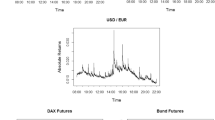Abstract
We find that incorporating nonlinearities into tests of asset price bubbles has important consequences for the results. We show this by comparing four tests using S&P 500 data. Our results indicate that the modification which incorporates nonlinear probabilities outperforms the other models in terms of select information criteria and a likelihood-based test. In addition, the coefficients associated with the nonlinear terms have the expected sign and the estimated probabilities display larger movements during the late 1910s, early 1930s/1940s, and the 2000s.



Similar content being viewed by others
Notes
Below, we impose the restrictions that \(\beta _{C,b}<0\) and \(\beta _{S,b}>\beta _{C,b}\). The first condition states that as the bubble size increases the expected return in the collapsing regime should decrease (increase) if a positive (negative) bubble is present. The second condition implies that we expect the difference in expected returns across the surviving and collapsing regime to increase when the size of the bubble increases.
The theoretical condition \(0\le \partial g\left( b_{t}\right) /\partial b_{t}\le M\) is imposed on the data with the nonlinear specification through the restriction of \(M\ge \kappa >0\), but not with the linear system.
The estimation results using the period between January 1889 and January 2003 are nearly identical.
The monthly observations on the S&P price index, dividends, and the US Consumer Price Index (all items seasonally adjusted) are taken from Robert Shiller’s Web site. The monthly share volume is the monthly average of the daily share volume from the NYSE.
Equal distance in the Kullback–Leibler sense.
We have also considered an extended version of the modified BK model by linking the function \(g\left( .\right) \) in Eq. (6) to abnormal trading volume (\(J_{t}\)) and by relating \(q_{t}\) to the squared term of the return spread. This leads to a new regression equation for regime C and a specification of \(q_{t}\), namely
$$\begin{aligned}&\displaystyle R_{t+1}^{C} =\beta _{C,0}+\beta _{C,b}b_{t}+\beta _{C,J}J_{t}+\varepsilon _{t+1}^{C}. \\&\displaystyle q_{t} =\varPhi \left( \beta _{q,0}+\beta _{q,b}\left| b_{t}\right| +\beta _{q,J}J_{t}+\beta _{q,J2}J_{t}^{2}+\beta _{q,S}S_{t}+\beta _{q,S2}S_{t}^{2}\right) . \end{aligned}$$The log-likelihood value, AIC, and BIC of the extended model are identical to those of the modified BK model. The LR ratio test statistic and the estimated values of \(\beta _{C,J}\) and \(\beta _{q,S2}\) are insignificant. Therefore, the estimation results are not reported.
The figure from the EVN model is almost identical to that of the BK model.
References
Brooks C, Katsaris A (2005) A three-regime model of speculative behaviour: modelling the evolution of the s&p 500 composite index. Econ J 115:767–797
Campbell JY, Shiller RJ (1987) Cointegration and tests of present value models. J Polit Econ 95(5):1062–1088
Hamilton JD (1996) Specification testing in Markov-switching time-series models. J Econom 70(1):127–157
Maldonado WL, Tourinho OA, Valli M (2012) Exchange rate bubbles: fundamental value estimation and rational expectations test. J Int Money Finance 31(5):1033–1059
van Norden S (1996) Regime switching as a test for exchange rate bubbles. J Appl Econom 11(3):219–251
van Norden S, Schaller H (1993) The predictability of stock market regime: evidence from the toronto stock exchange. Rev Econ Stat 75(3):505–510
van Norden S, Schaller H (1999) Speculative behaviour, regime-switching and stock market crashes. In: Rothman P (ed) Dynamic modeling and econometrics in economics and finance, vol 1. Springer, New York, pp 321–356
Vuong QH (1989) Likelihood ratio tests for model selection and non-nested hypotheses. Econom J Econom Soc 57(2):307–333
White H (1987) Specification testing in dynamic models. In: Bewley TF (ed) Advances in Econometrics, Fifth World Congress, vol 1. Cambridge University Press, Cambridge, pp 1–58
Author information
Authors and Affiliations
Corresponding author
Additional information
The analysis and conclusions expressed here are those of the authors and not necessarily those of the U.S. Energy Information Administration.
Rights and permissions
About this article
Cite this article
Arora, V., Shi, S. Nonlinearities and tests of asset price bubbles. Empir Econ 50, 1421–1433 (2016). https://doi.org/10.1007/s00181-015-0976-1
Received:
Accepted:
Published:
Issue Date:
DOI: https://doi.org/10.1007/s00181-015-0976-1




